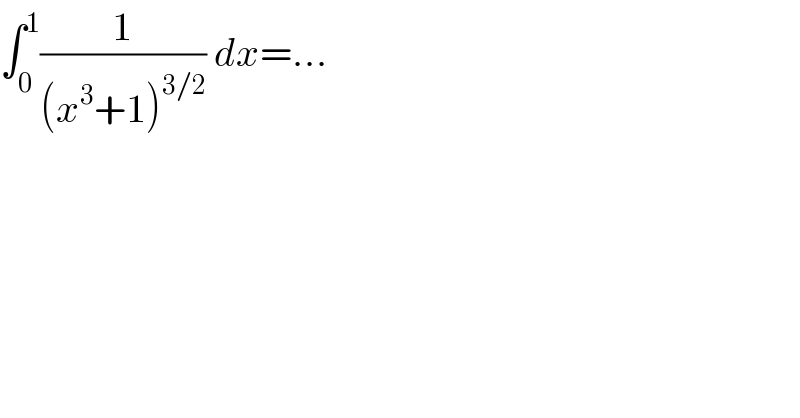
Question and Answers Forum
Question Number 53078 by gunawan last updated on 16/Jan/19

Commented by MJS last updated on 17/Jan/19

Answered by tanmay.chaudhury50@gmail.com last updated on 17/Jan/19
![1+x^3 >1+x^2 (1/(1+x^3 ))<(1/(1+x^2 )) but in the interval [0,1] (1/((1+x^3 )^(3/2) ))>(1/((1+x^2 )^(3/2) so)) i am rectifying ∫_0 ^1 (dx/((1+x^3 )^(3/2) ))>∫_0 ^1 (dx/((1+x^2 )^(3/2) )) now ∫_0 ^1 (dx/((1+x^2 )^(3/2) )) x=tana ∫_0 ^(π/4) ((sec^2 a)/((1+tan^2 a)^(3/2) ))da ∫_0 ^(π/4) ((sec^2 ada)/(sec^3 a)) ∫_0 ^(π/4) cosada ∣sina∣_0 ^(π/4) =(1/(√2)) so I>(1/(√2)) I>0.71 attaching graph... answer yet to find....](Q53088.png)
Commented by tanmay.chaudhury50@gmail.com last updated on 17/Jan/19

Commented by tanmay.chaudhury50@gmail.com last updated on 17/Jan/19
![area of trapazium calculation whenf(x)=(1/((1+x^3 )^(3/2) )) at x=1 f(1)=(1/((2)^(3/2) ))=(1/(2(√2))) at x=0 f(0)=(1/((1+0)^(3/2) ))=1 so area of trapazium=(1/2)[f(0)+f(1)]×1 =(1/2)(1+(1/(2(√2))))×1=0.68 from graph it is clear that area bounded i,e ∫_0 ^1 (dx/((1+x^3 )^(3/2) ))>0.68](Q53092.png)
